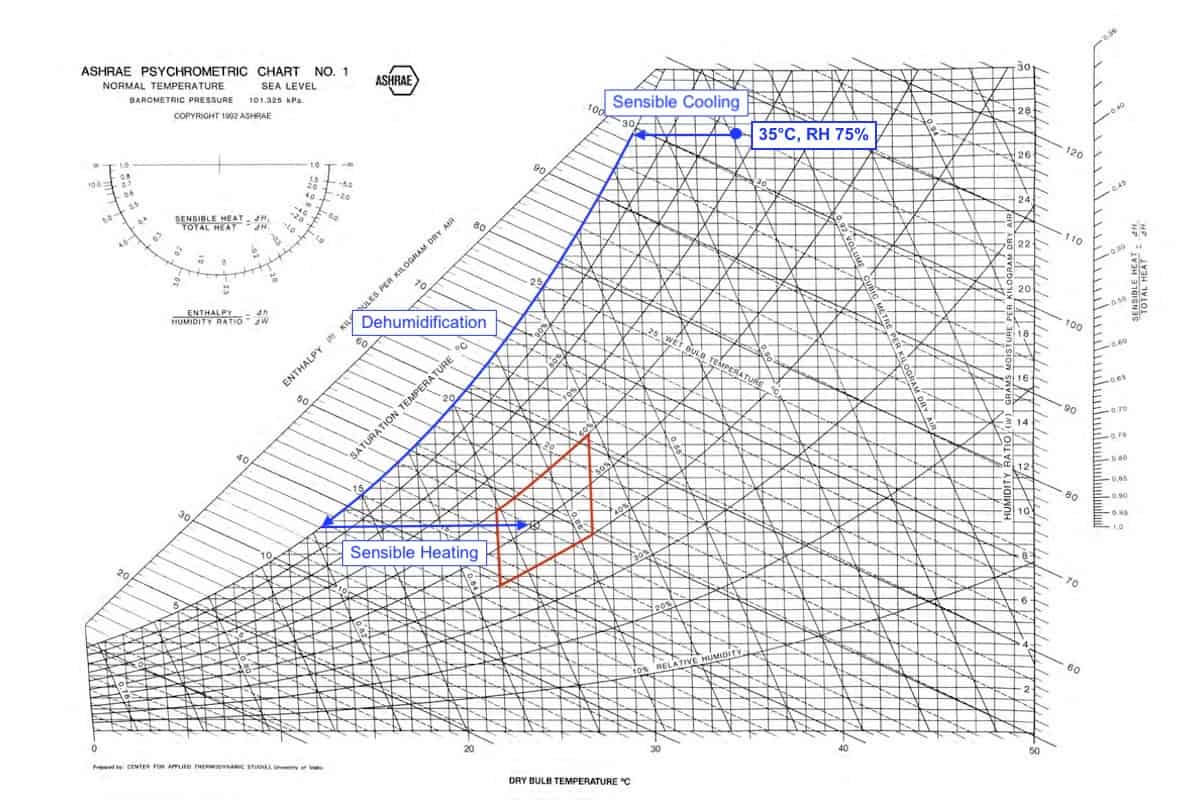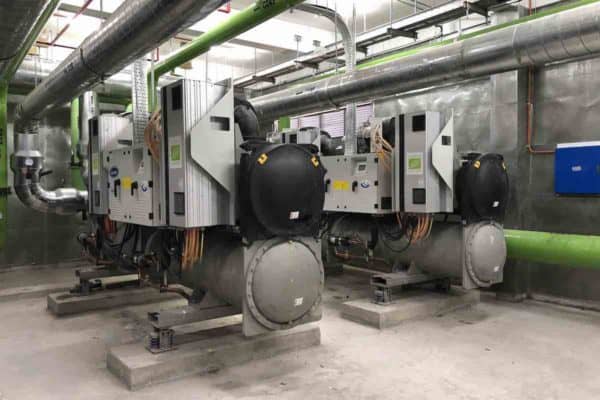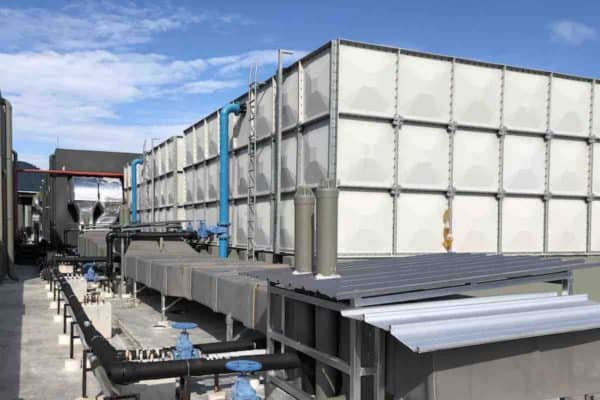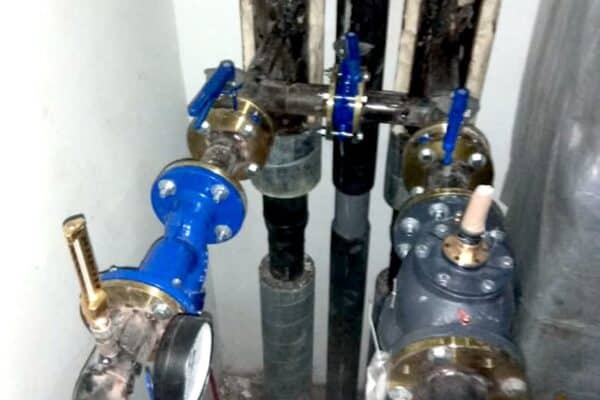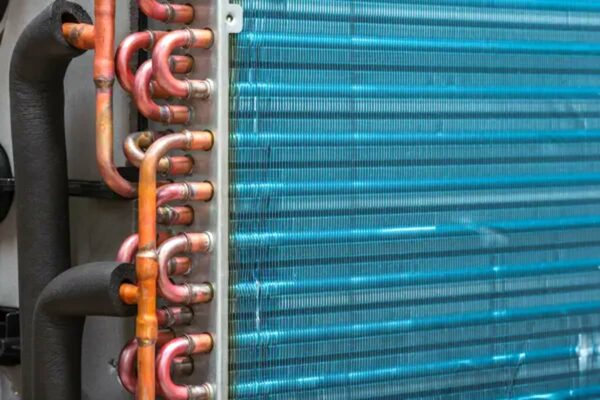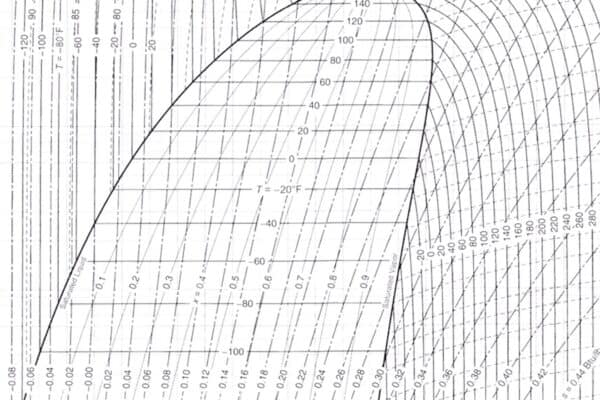How to Use a Psychrometric Chart?
Psychrometric Chart is very useful in air conditioning. By using a psychrometric chart, we can find ways to achieve thermal comfort under any given air condition. So, how can you use a psychrometric chart?
A psychrometric chart can be used for the following:
- Determine ways to achieve thermal comfort in hot and humid places.
- Determine ways to achieve thermal comfort in hot and dry places.
- Determine ways to achieve thermal comfort in cold and humid places.
- Determine ways to achieve thermal comfort in cold and dry places.
There are other applications of a psychrometric chart but the above four are the most fundamental ones. By mastering the psychrometric chart, you can design a good air conditioning system no matter what is the outdoor condition.
If you are not sure how to read a psychrometric chart, I suggest you see my post How to Read a Psychrometric Chart? before you proceed further in this post.
Thermal Comfort Zone
Generally, people feel comfortable at a temperature between 22°C and 27°C and relative humidity between 40% and 60%.
This comfort zone can be represented in the psychrometric chart as follow:
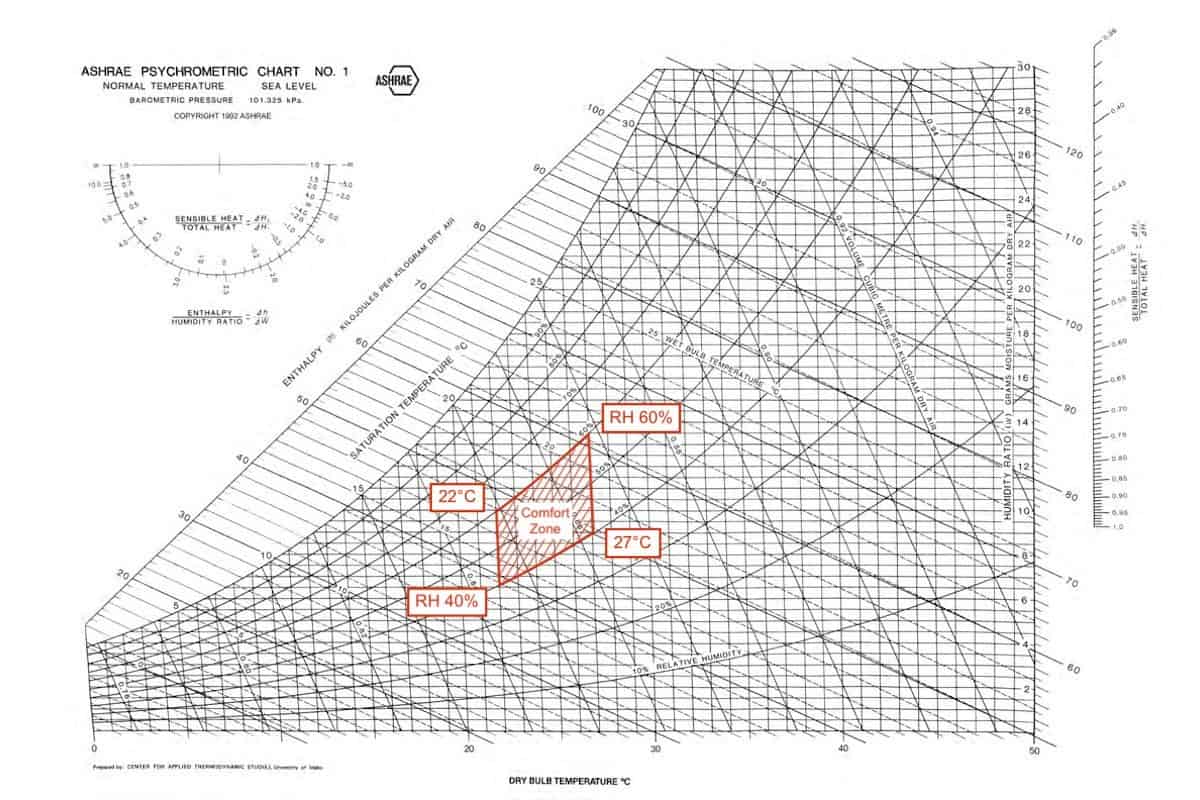
On this planet, different places have different climates. Meaning, different places have different outdoor air temperatures and relative humidity.
For example, the outdoor air temperature and relative humidity in Malaysia can be around 35°C and 75% respectively. With such an outdoor air condition, Malaysia alongside Singapore and Thailand is considered as having a hot and humid climate.
On the other hand, the outdoor air temperature and relative humidity in Egypt can be around 32°C and 20% respectively which is considered as having a hot and dry climate.
Meanwhile, the outdoor air temperature and relative humidity in Finland can be around 10°C and 20% respectively which is considered as having a cold and dry climate.
In the United States, places like Las Vegas are considered as having a cold and dry climate with an outdoor air temperature and relative humidity of around 15°C and 25% respectively.
Now, as an air conditioning design engineer, your job is to determine the outdoor air condition and find ways to reach the thermal comfort zone as per stipulated in the above psychrometric chart.
However, if you are not designing an air conditioning system for thermal comfort, that’s a different story and this post will not be directly applicable but still, relatable.
In the meantime, I would like to inform you that you can learn quicker by getting my HVAC Begin (eBook) if you’re a beginner. But, if you have a year or two of experience, then I would suggest you consider my HVAC Basics (eBook). Nonetheless, I encourage you enroll in my HVAC Beginner Course: 10 Days to Become Competent in HVAC if you want to equipped yourself with a complete set of basic HVAC skills.
HVAC Beginner Course
Learn the most basics and foundational HVAC skills including cooling capacity calculation, equipment selection, duct sizing, pipe sizing, exhaust fan sizing, controls, electrical and more.
Hot and Humid Climate
Places with a hot and humid climate are having high outdoor air temperature and high relative humidity. People feel very uncomfortable staying in rooms with such an air condition.
So, you need to design an air conditioning system that can bring the high temperature and high relative humidity down to the comfort zone.
The path to bringing a hot and humid air condition to the comfort zone can be illustrated in the psychrometric chart as follow:
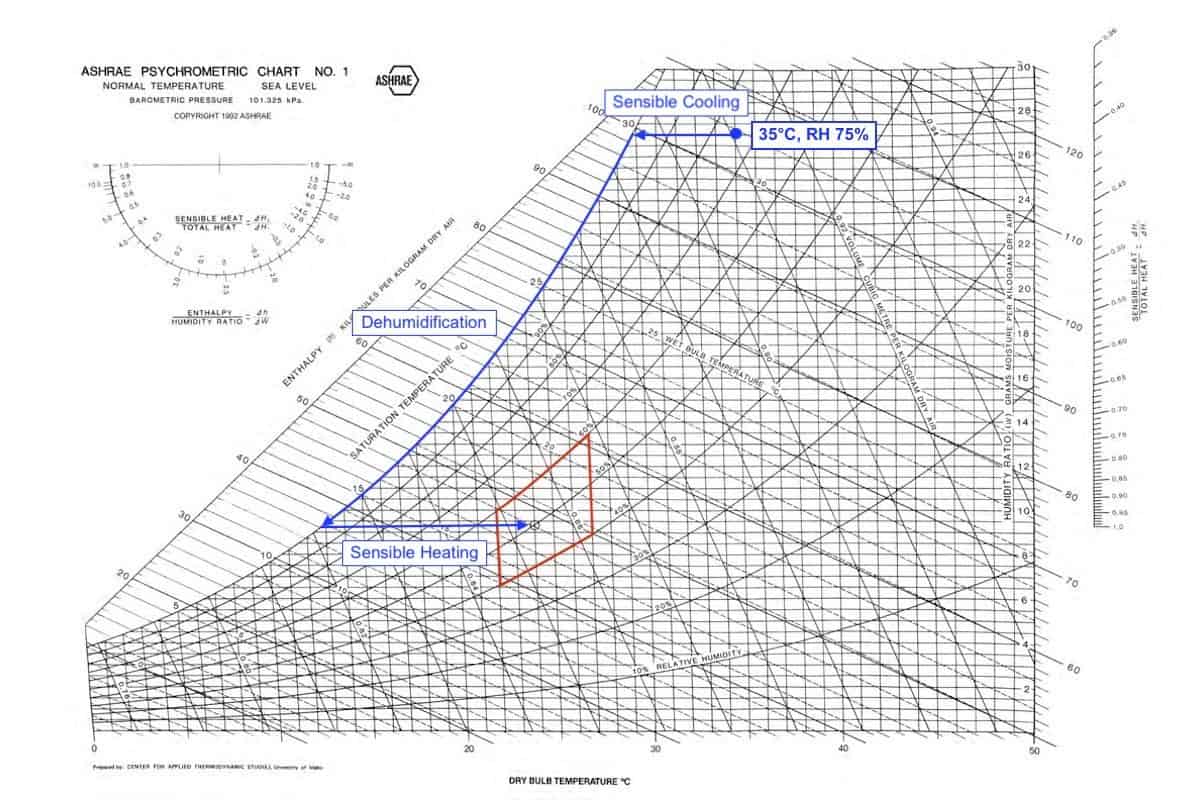
To find the path to reach the comfort zone, first identify the air condition which is a temperature of 35°C and relative humidity of 75%, for example. Then, find a way to bring that air condition to the comfort zone.
You can do a 90-degree bend that moves vertically down and horizontally to the left to reach the comfort zone faster. By doing so, you need to reduce the moisture content in the air (dehumidification) and then cool the air sensibly.
For such a dehumidification method, you can use desiccant. However, it is not sustainable. As for sensible cooling, you can use ice but it is not sustainable as well.
So, the most common way of dealing with a hot and humid climate is to use a heat exchanger or cooling coil that cools below the dew point of the air for dehumidification while cooling.
Assuming that you’re aiming to reach an air condition with a temperature of 24°C and relative humidity of 50%, the dew point of the air is 13°C.
Thus, you need to make sure that the surface temperature of the cooling coil is around 13°C in order to perform dehumidification sufficiently.
With a cooling coil that has a surface temperature of 13°C, the outdoor air that doesn’t come into direct contact with the cooling coil will go through the sensible cooling process.
The outdoor air that does contact with the cold cooling coil will start to condensate and go through the dehumidification process.
For room air conditioning, the process usually ends here where the supply air temperature is around 13°C. The heat gain in the space will heat up the supply air and eventually get the temperature up to the comfort zone.
However, if you are dealing with precision air conditioning where there is no additional heat gain to bring the supply air to the comfort zone, you need to perform the sensible heating process manually.
For sensible heating, the most common method is by using an electric resistance heater. Alternatively, you also can use a heat pipe to achieve the same goal.
Therefore, a typical pre-cooled air handling unit (PAHU) in a hot and humid climate will have either an electric resistance heater or a heat pipe coupled with a cooling coil to treat the outdoor air before sending it to other AHUs or directly supply it into rooms.
Hot and Dry Climate
Places with a hot and dry climate are having high outdoor air temperatures but low relative humidity. People don’t feel comfortable staying in rooms with such a hot and dry air condition.
So, you need to design an air conditioning system that can reduce the temperature and moisturize the air up to the comfort zone.
The path to bringing a hot and dry air condition to the comfort zone can be illustrated in the psychrometric chart as follow:
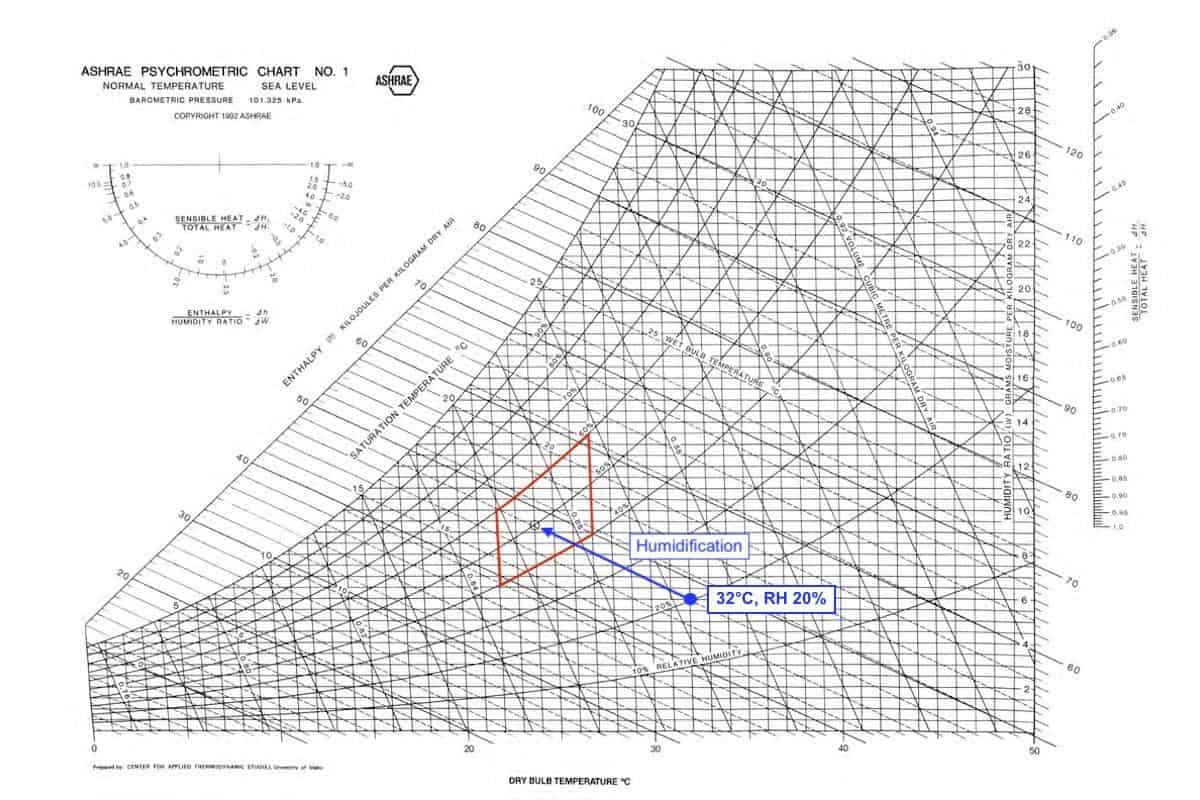
Humidification often is the only process that is needed to provide thermal comfort in a hot and dry climate. Such a process is also known as evaporative cooling.
For evaporative cooling, you need to humidify the air using water vapor that has a lower temperature than the air. If you use warm water vapor, the process will go in the opposite direction.
There are a lot of evaporative coolers available on the market. Generally, evaporative coolers work best in hot and dry places because there is a lot of room in the air for moisture to fill.
If you use an evaporative cooler in a humid place, there is little to no room in the air for water vapor. Hence, humidification is limited and therefore, temperature reduction is also limited.
Cold and Humid Climate
Places with a cold and humid climate are having low outdoor air temperature but high relative humidity. People also don’t feel comfortable staying in rooms with such a cold and clammy air condition.
So, you need to design an air conditioning system that can increase the temperature and reduce the relative humidity down to the comfort zone.
The path to bring a cold and humid air condition to the comfort zone can be illustrated in the psychrometric chart as follow:
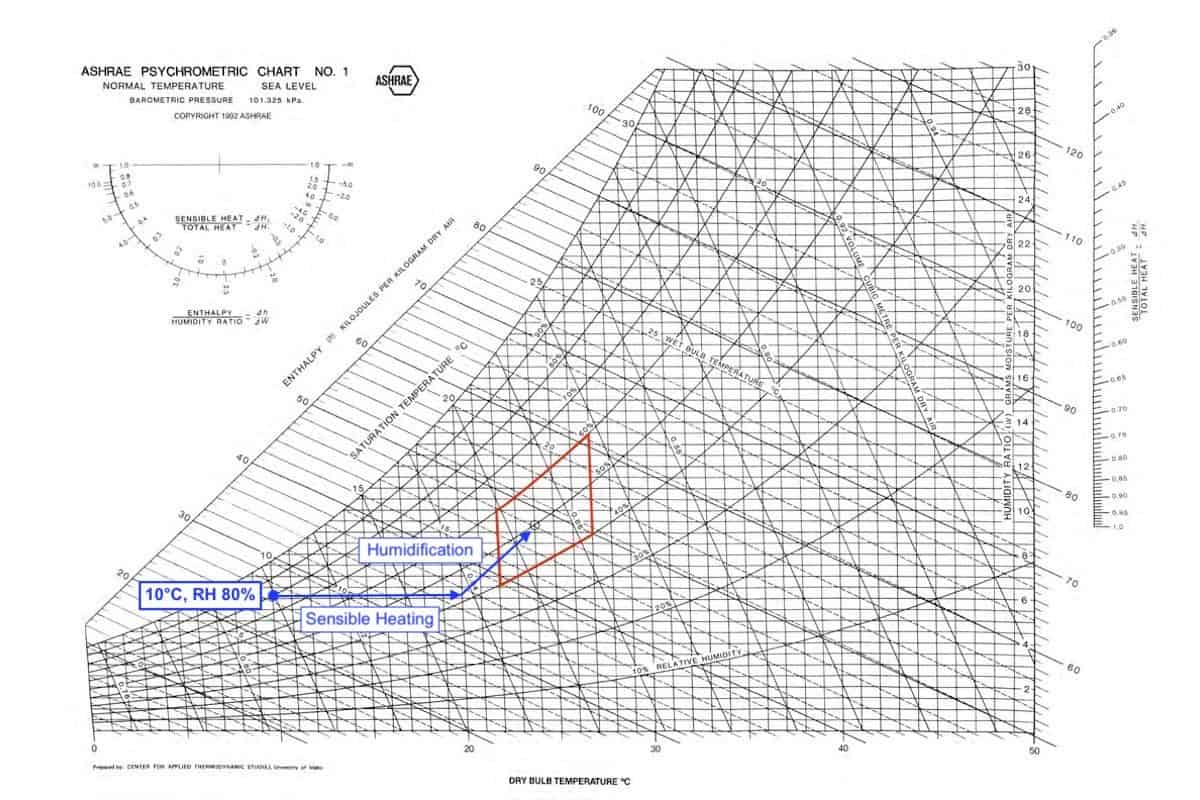
Starting with the 10°C and RH 80% air condition, you need to perform the sensible heating process using an electric resistance heater and then humidify the air with warm water vapor.
If cold water vapor is used, the humidification process will lean towards the left side which is reducing the temperature of the air and you certainly don’t want that to happen.
Often, sensible heating alone is enough to achieve thermal comfort especially when the relative humidity is very high at a level above 90%.
As the air is being heated, its ability to hold moisture improves and thus, its relative humidity drops.
Furthermore, humans do emit some water vapor into the air. That’s why houses in a cold and humid climate usually don’t need a humidifier.
Cold and Dry Climate
Places with a cold and dry climate are having low outdoor air temperature and low relative humidity. People certainly don’t feel comfortable staying in rooms with such a cold and dry air condition.
So, you need to design an air conditioning system that can increase the temperature and the relative humidity at the same time to reach the comfort zone.
The path to bringing a cold and dry air condition to the comfort zone can be illustrated in the psychrometric chart as follow:
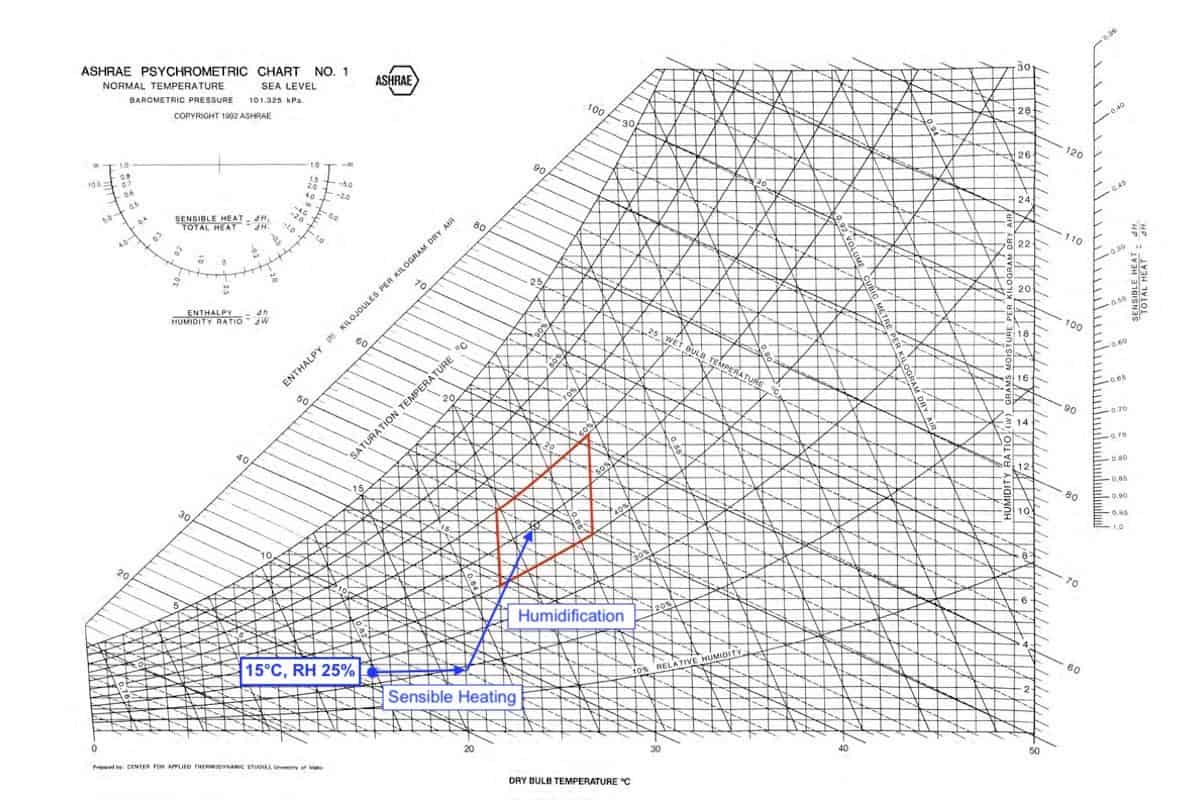
The air conditioning process for cold and dry climates is similar to cold and humid climates except for a cold and dry climate that mostly needs a humidifier to achieve thermal comfort.
As you can see from the above chart, the humidification process is significantly longer. It indicates that humidification is certainly required.
We know that the air becomes dryer when heated. In this case, if humidification is not done, the air will be too dry after the sensible heating process.
Hence, AHUs for such applications usually are equipped with a steam humidifier on top of an electric resistance heater.
If you’re able to increase the temperature of the steam humidifier, the sensible heating process, which uses more energy can be shortened and operating costs can be reduced.
Final Thought
Psychrometric Chart is all about the properties of air and the properties of air is fundamental to air conditioning. By understanding and using the psychrometric chart, we can determine ways to achieve thermal comfort or any given air condition regardless of where we are.
Lastly, consider my HVAC Begin (eBook) if you’re a beginner and you want to have a foundational knowledge in HVAC. But, if you have a year or two of experience, then I would suggest you consider my HVAC Basics (eBook). Nonetheless, I encourage you enroll in my HVAC Beginner Course: 10 Days to Become Competent in HVAC if you want to equipped yourself with a complete set of basic HVAC skills.
HVAC Beginner Course
Learn the most basics and foundational HVAC skills including cooling capacity calculation, equipment selection, duct sizing, pipe sizing, exhaust fan sizing, controls, electrical and more.
If you have anything to add (or ask) about this topic, leave a comment down below!


